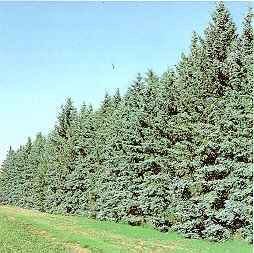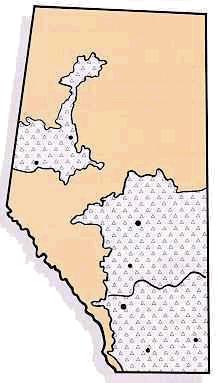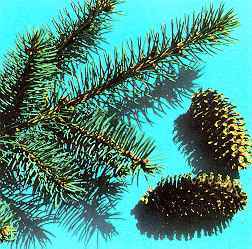| | Plant Characteristics | Site Preference | Hardiness | Uses | Problems | Insects and Diseases | Pruning
.
 . .
Scientific Name: Picea pungens Engelm.
Plant Characteristics
Colorado spruce is native to the Rocky Mountains in the Western United States. This is the most widely planted of the spruce.
Colorado spruce has a pyramidical shape. It is a long lived tree from 50 to 100 years. It can reach the height of 25 m (80 ft), with a spread of 6 m (20 ft). Growth rate is slow for the first three to five years after planting but will increase annually. Colorado spruce is a slow growing tree if kept in a shaded location.
Leaves - The branches spread horizontally in whorls. Needles are rigid, 2 to 3 cm (0.75 to 1.25 in.) long, spiny-pointed, grey blue to green, rarely dull green.
Cones - Cones are from 6 to 10 cm (2.5 to 4 in.) long, straw coloured with thin scales, found in the upper branches of the tree.
The winged seeds are shed in August and the cones drop during fall and winter. Cones require one year to mature. Needles last for three to four years then turn yellow and fall from the inside of the tree.
Bark - The bark is a platy cinnamon colour. Buds are a brownish yellow.
Site Preference
Colorado spruce will tolerate a wide range of soils, from clay to clay loam, and well drained sandy soil. Will not tolerate flooding. Will survive short periods of low moisture.
Prefers acid soil. Will not tolerate medium to high salts. Prefers full sun. It can withstand some shade, but will grow slowly in heavy shade.
Hardiness
Fully winter hardy, growth rate is slow for up to the first five years after planting, but will increase annually from 20 to 60 cm (8 to 24 in.) thereafter. Young seedlings are susceptible to sun scald and should be protected.
.


Uses
This is another valuable evergreen tree for shelterbelt planting. It is most commonly used in multiple-row shelterbelts as an inside row, (on the protected side of the belt). Recommended spacing is 2 to 4 m (6 to 13 ft) between trees in a row and 5 to 8 m (17 to 26 ft) away from adjacent rows. Often used in grouping, accent planting. Colorado spruce provides thermal cover in winter, also nesting and roosting cover for small birds. Since the needles are sharp, the branches are browsed only during food shortage.
Problems
Seedlings require more care for the first three to five years. Prone to sunscald, it does not perform well on unprotected sites.
Insects and Diseases
Colorado spruce are infrequently damaged by pests. Cytospora canker may attack lower branches as the tree matures. Infestation of red spider mites and yellowheaded sawfly have been noted, along with spruce gall aphids. They are subject to pine-needle scale.
Pruning
Pruning is not required, unless there is a double leader, then one should be removed. If a leader is not present, a new leader must be trained. Remove leader and burn if boring insects are present.
.

Shelterbelts Varieties for Alberta provides information on a number of other trees and shrubs than may be suitable for shelterbelts.
Visit our website directory for the Reforestation Woodlot Listings. |
|